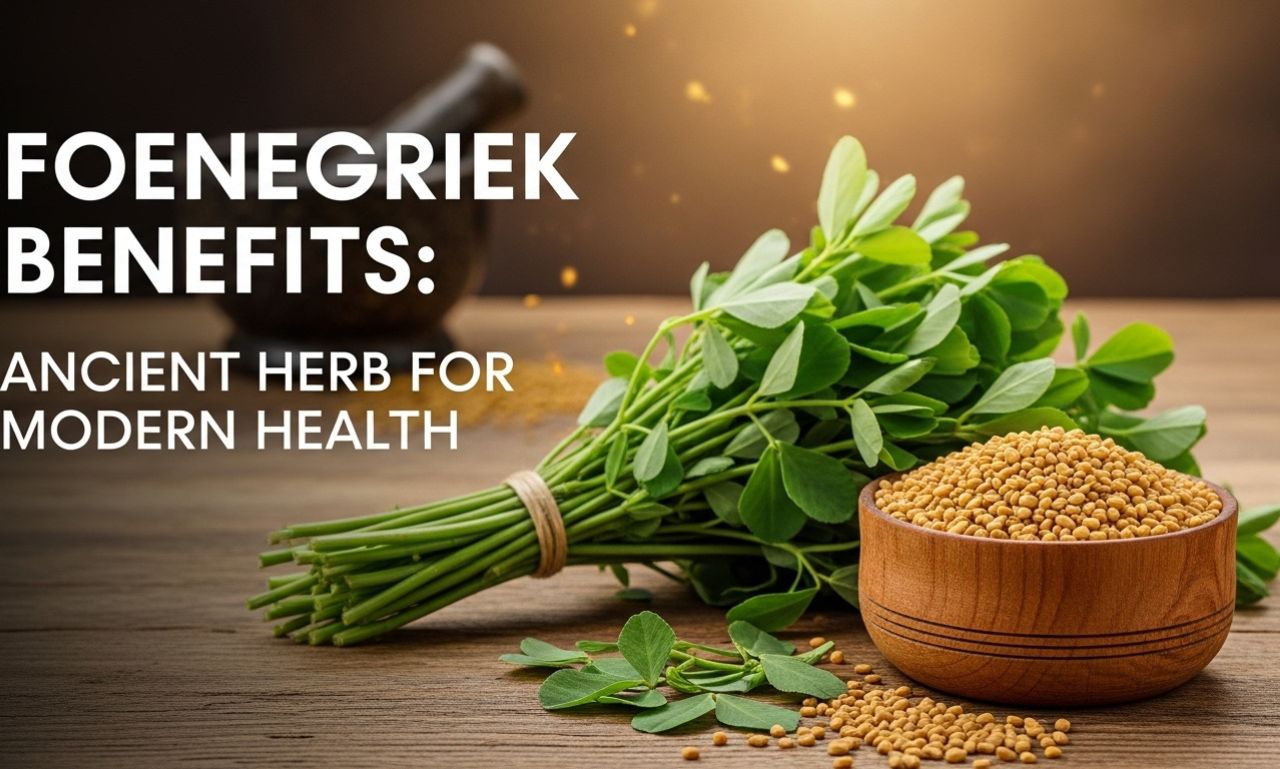In the world of herbal wellness and nutrition, foenegriek has quietly risen from ancient kitchens and apothecaries into mainstream interest. This remarkable herb, known internationally by its Latin name Trigonella foenum-graecum, brings together centuries of traditional use and modern science. In this article you’ll discover what foenegriek really is, how it has been used across cultures, its nutritional profile, potential health benefits, practical applications, and important safety considerations. If you’re curious about how to integrate a timeless herb into contemporary lifestyle — stay with me.
Understanding foenegriek: what it is and why it matters
At its core, foenegriek is a legume-family plant which yields small golden-brown seeds and, in some cases, leaves that are used much like herbs. Its botanical history runs deep: it has been cultivated since ancient times in the Mediterranean, western Asia and parts of India.
The term “foenegriek” is derived from Dutch (fenegriek) or Flemish (foenegriek) and refers directly to this same herb known in English as fenugreek. The seeds hold a warm nutty-maple aroma and flavour, making them distinctive in culinary and medicinal uses.
Why does foenegriek matter? Because in an era where people seek ancient wisdom alongside evidence-based wellness, foenegriek bridges the gap. It is versatile, accessible, and relatively low cost — yet it comes with caveats. In the sections ahead you’ll see both promise and caution.
Historical use of foenegriek in cuisine and culture
From ancient Egypt to Indian Ayurveda, and Moroccan tagines to Dutch bread‐making, foenegriek has travelled widely. According to sources, the Romans flavoured wine with fenugreek seeds, and Egyptians found the seeds in tombs.
In North Africa and the Middle East, the leaves and seeds of foenegriek feature in stews, breads and spice blends, valued for their flavour and reputed benefits.
In the Dutch/Belgian context, foenegriek seeds were historically used to feed horses (hence “Greek hay”), and later found their way into human dietary uses.
This cultural journey adds credibility to the herb’s staying power: when a plant appears in multiple cuisines and medicinal traditions, that suggests something more than a passing trend.
Nutritional profile of foenegriek seeds and leaves
While many people treat foenegriek as a spice or remedy, its nutritional make-up is meaningful. According to a recent analysis, one tablespoon (~11 g) of foenegriek seeds contains approximately 35 calories, with 3g fibre, 3g protein, and significant iron and magnesium.
Beyond macronutrients, the seeds contain phytochemicals: saponins, flavonoids, and alkaloids (notably trigonelline).
Key micronutrients include:
-
Iron: ~3.7 mg (about 20–21% of daily value for some adults)
-
Magnesium, manganese, and other minerals in modest amounts
Because of its fibre content, foene griek may support digestive health and satiety. The presence of these compounds suggests that foene griek is more than just flavour — it has substance.
How to use foenegriek in everyday cooking
Integrating foene griek into your diet can be both simple and creative. Here are some practical suggestions:
-
Seeds: Dry‐roast the seeds lightly to reduce bitterness and bring out a nutty flavour. Then grind or use whole in spice blends.
-
Leaves: If available fresh or dried, foene griek leaves (often called methi in Indian cuisine) can be used in flatbreads, stews or mixed veggie dishes.
-
Tea or infusion: Some people steep foene griek seeds in hot water to make a simple herbal beverage.
-
Pickles and breads: In Middle Eastern cooking, foene griek seeds appear in breads and pastries for their flavour and aroma.
Tip: Start with a small amount (½ to 1 teaspoon of seeds) when adding to new recipes, since the flavour can be strong and somewhat bitter if raw. Roasting helps soften that.
Potential health benefits of foenegriek
Here we venture into what modern research suggests about foene griek — while also emphasising that many claims remain preliminary.
Blood sugar regulation
Several studies suggest that foene griek seeds may help moderate post-meal blood sugar spikes in people with type 2 diabetes or pre-diabetes. The soluble fibre and galactomannan content help slow carbohydrate absorption, which is one mechanism.
Digestive health and appetite
Because foenegriek is rich in fibre and has mucilaginous (gel-forming) components, it may support gut motility, ease of digestion, and a feeling of fullness. Some reports suggest it can soothe stomach lining and support digestive comfort.
Hormonal and lactation support
Traditionally, foenegriek has been used as a galactagogue (to support breast-milk production). There’s emerging evidence, though mixed, supporting this use. Some small clinical studies have also looked at effects on male testosterone levels and female libido, with modest results.
Some early data indicate that foene griek may modestly reduce LDL cholesterol and triglycerides — likely via its fibre and saponin content which reduce absorption of cholesterol in the gut.
Skin, hair & inflammation
Emerging trends highlight foene griek’s use for skin and hair: applying seed pastes to soothe irritation, or using extracts for hair-strengthening. While anecdotal, these uses reflect the herb’s anti-inflammatory components.
Safety considerations and possible side-effects
Despite the many promising aspects of foene griek, caution is required. According to authoritative sources:
-
It is generally safe when consumed in food amounts.
-
However, higher doses (as in supplements) may carry risks: for example, in pregnancy foenegriek might stimulate uterine contractions and is not recommended in pharmaceutic doses.
-
It can lower blood sugar; thus individuals on diabetic medications should monitor closely to avoid hypoglycemia.
-
Some people with peanut or chickpea allergies (legume family) may also be allergic to foenegriek.
-
There may be interactions with anticoagulants (blood-thinners) because foenegriek might affect clot-forming.
Best practice: If you’re pregnant, breastfeeding, on medication (especially for diabetes or blood clotting), or planning surgery, consult a healthcare professional before using foenegriek in therapeutic doses.
Latest research & trends in foenegriek use
Recent articles highlight that research quality around foenegriek is still variable. For example, a 2023/2024 overview concluded that while there are promising signals (for blood sugar, lactation, hormone support), many trials are small, heterogeneous, and need more robust design.
Moreover, newer trends include:
-
Using foene griek in hair-care products (shampoos, conditioners) because of purported strengthening and anti-inflammatory effects.
-
Culinary innovation in European health-food markets: roasted foenegriek seeds as snack toppings, micro-greens of foenegriek leaves, blends with other adaptogenic herbs.
-
Animal-feed applications: In equine nutrition, foenegriek is used for digestion and coat quality.
These trends reflect how foenegriek is not just a spice but part of a broader wellness movement. That said, we must temper enthusiasm with an understanding of the limits of evidence.
Choosing quality foenegriek: what to look for
When you purchase foene griek (seeds, powder, extracts), consider the following:
-
Source & origin: Prefer seeds from reputable geographic regions with good agricultural practices.
-
Freshness: Seeds should smell warm and slightly maple-like; rancid or flat smell suggests old or poor quality.
-
Processing: If buying powder, ensure minimal additives and appropriate packaging (sealed, light-protected).
-
Certifications: For supplements or powders, look for third-party testing (purity, absence of heavy metals).
-
Dosage clarity: If you intend to use therapeutic amounts, ensure the label specifies standardised extract amounts (and consult a professional).
By selecting well-produced foenegriek, you maximise the chance of beneficial effects and minimise contamination or diminished potency.
Integrating foenegriek into a wellness lifestyle
Beyond simply using foene griek, consider these holistic ways to integrate it:
-
Pair foenegriek with a diet rich in whole-grains, vegetables and legumes — since the herb’s fibre and phytochemicals work best in a nutrient-diverse context.
-
Use it as part of a flavour rotation: e.g., replace ¼-½ of your normal spice blend with roasted foenegriek seeds for one meal per week.
-
Combine with gentle movement (walks, yoga, mobility work) and stress-management (meditation). Herbs are supportive — lifestyle matters too.
-
Keep a small journal: note how your digestive system, energy levels or even skin respond after introducing foenegriek for a month. Personal tracking helps you see what works.
-
Stay informed: As research evolves, new findings may refine recommended uses, dosages and contra-indications for foenegriek.
Common misconceptions about foenegriek
There are a few myths or exaggerated claims around foenegriek that deserve clarification:
-
Myth: “Foenegriek cures diabetes.”
Clarification: While foenegriek may support blood sugar regulation, it is not a cure for diabetes and cannot replace medical treatment. Evidence is still limited. -
Myth: “Because it’s natural, foenegriek has no side-effects.”
Clarification: Natural doesn’t always mean risk-free. Allergies, interactions, dosage issues apply. See safety notes above. -
Myth: “You have to take huge amounts to benefit.”
Clarification: Often small, food-level uses are sufficient for flavour and modest benefit; large doses increase risk without proven additional benefit.
By being clear about what foene griek can and cannot do, you position yourself for realistic, safe use.
Frequently Asked Questions (FAQs)
What is the difference between foenegriek seeds and leaves?
The seeds are the more commonly used form and carry most of the phytochemicals; the leaves are milder, used as a vegetable or herb, and provide flavour plus some nutrients but fewer of the medicinal compounds.
Can I use foenegriek every day?
Yes, in the amounts used for cooking (small teaspoons) it is generally safe for most people. But if you plan therapeutic use daily (e.g., for blood sugar or lactation), you should consult your healthcare provider.
How much foenegriek should I add to my food?
For culinary use, start with ½ to 1 teaspoon of roasted seeds per meal, or a small handful of leaves. For supplement use (which is different), follow label instructions and medical advice.
Will foenegriek show up on allergy tests or cause cross-reactions?
If you’re allergic to legumes like peanuts or chickpeas, there is a possibility you may react to foenegriek since it belongs to the same broad family.
Can foenegriek help with weight management?
Indirectly, yes — the fibre and satiety effect, plus support for blood sugar, may help moderate appetite or reduce overeating. But it’s not a “weight-loss herb” in isolation.
Is foenegriek safe during pregnancy or for children?
During pregnancy, higher-dose foenegriek may stimulate uterine contractions and is considered unsafe for medicinal use. For children, normal food levels are usually fine but supplement use should be avoided unless under professional guidance.
Conclusion
In summary, foenegriek offers a compelling blend of tradition, flavour and potential wellness support. It is not a miracle cure — but as part of a balanced diet and healthy lifestyle, it holds value. The key is moderation, quality sourcing, and informed use.
If you are looking to deepen your use of herbs, experiment with new flavours, support digestion or explore gentle blood-sugar support, foenegriek is a worthy addition. On the other hand, if you expect dramatic results overnight — manage your expectations. Health is a long game.

